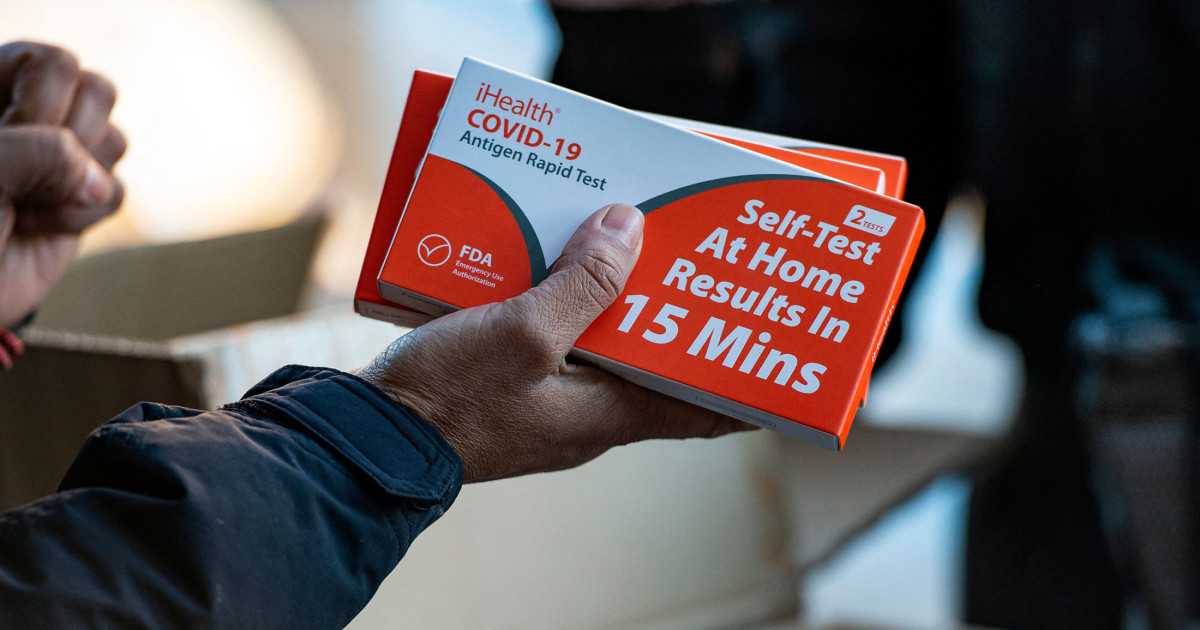
Each U.S. household can now order four more free Covid tests, to be sent out by the federal government starting the week of Nov. 27.
The Department of Health and Human Services announced the new round of test shipments Monday as the holiday season begins — a time when public health experts typically expect cases of Covid, flu, colds and respiratory syncytial virus to surge.
As with the previous five rounds of government-issued Covid tests, orders can be placed online at Covid.gov. People who didn’t take advantage of the last offer in September can still order the four rapid antigen tests made available then, for a total of eight tests. The only information required is a name and a home address — no health insurance information needed.
The order page warns that although tests may arrive with expiration dates that have passed, the Food and Drug Administration has extended the dates for most approved tests. So users can check the true expiration dates of their Covid tests on the FDA’s regularly updated list.
According to the Centers for Disease Control and Prevention, Covid hospitalizations and deaths both rose by around 9% during the week ending Nov. 11 — the most recent data publicly available. The test positivity rate stayed flat, meanwhile, with just over 8% of PCR tests coming back positive. Overall, Covid hospitalizations and deaths remain low for this time of year compared to previous years.
Why testing for Covid is still useful
Dr. Amesh Adalja, an infectious disease physician and senior scholar at the Johns Hopkins Center for Health Security, said people don’t need to test with the same rigor as at the height of the pandemic. But for groups vulnerable to severe illness — those who are immunocompromised, have underlying health conditions or are ages 50 and up — identifying a Covid case is a crucial step to getting treatment.
“There is a benefit to testing in order to get antiviral therapy if you’re somebody that’s high-risk,” Adalja said.
Testing is also beneficial to protect loved ones, Adalja said: “The other way people use it is ‘I’m going to be around a lot of high-risk people, and I just want to make sure I’m not contagious.’”
A Covid test can help distinguish an infection from other respiratory viruses, as well, Adalja added — a task that has become more difficult as Covid’s most distinctive symptoms, like loss of taste and smell, have become less ubiquitous. As with many other illnesses, a sore throat and congestion are common Covid hallmarks.
Seasonal increases in the spread of flu and RSV have already been detected, according to the CDC.
“If you’re sick with something, you’ve got a fever, cough, whatever it might be, and you take a Covid test and it’s positive, you have your answer,” Adalja said. “And then you can take the requisite steps of isolation or getting a prescription for Paxlovid if that’s something you qualify for.”
Still, he noted, people should make testing decisions based on their individual vulnerability to Covid, because there’s no longer a “one-size fits all recommendation.”
“A lot of people are risk-acclimatized and recognize Covid as an endemic illness. So they may not necessarily think of it differently than other respiratory viruses,” Adalja said.
What to do if you test positive for Covid
At-home tests will show that double line only when there’s “enough virus to trigger a positive,” Adalja said. So if someone feels sick but tests negative, he advised waiting a couple days, then testing again. People who are high-risk should consider getting a “more formal test,” Adalja added: a PCR test administered at a health care facility.
If you test positive, CDC guidelines suggest most people should isolate for five days, whether or not they develop symptoms. If symptoms do arise, the day they start counts as day zero — even if that means restarting the clock after a previous positive test.
Isolation can end after day five if symptoms are improving and you are fever-free for 24 hours without the use of medication. If that’s not the case, or if your Covid infection brought shortness of breath or a trip to the hospital, the CDC recommends a 10-day isolation.






